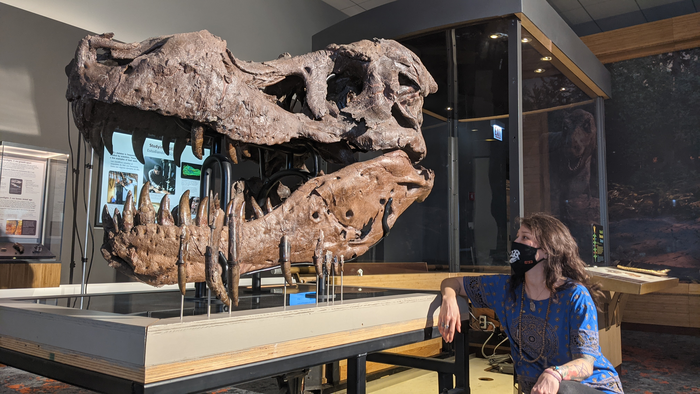SUE the T. rex is one of the most complete, best-preserved Tyrannosaurus rex specimens ever found. That level of preservation helps reveal details about SUE’s life. For instance, SUE lived to a ripe old age of about thirty-three, and in those years, suffered their fair share of injuries. SUE’s most mysterious ailment might be the holes in their jawbone. These holes, some the diameter of a golf ball, dot the back half of the left lower jaw. It’s not clear what caused them, but similar injuries have been found in other T. rex fossils. In a new study published in Cretaceous Research, scientists showed that one of the popular theories– that SUE had suffered an infection from a protozoan parasite– couldn’t be true.

Credit: Katharine Uhrich, Field Museum
SUE the T. rex is one of the most complete, best-preserved Tyrannosaurus rex specimens ever found. That level of preservation helps reveal details about SUE’s life. For instance, SUE lived to a ripe old age of about thirty-three, and in those years, suffered their fair share of injuries. SUE’s most mysterious ailment might be the holes in their jawbone. These holes, some the diameter of a golf ball, dot the back half of the left lower jaw. It’s not clear what caused them, but similar injuries have been found in other T. rex fossils. In a new study published in Cretaceous Research, scientists showed that one of the popular theories– that SUE had suffered an infection from a protozoan parasite– couldn’t be true.
“These holes in SUE’s jaw have been a mystery for decades,” says Jingmai O’Connor, the associate curator of fossil reptiles at Chicago’s Field Museum and a co-author of the study. “Nobody knows how they formed, and there have been lots of guesses.”
One early hypothesis was that SUE suffered from a fungus-like bacterial infection, but that was later shown to be unlikely. It was re-hypothesized that SUE had a protozoan infection. Protozoans are microbes with more complex cell structures than bacteria. There are lots of protozoan-caused maladies out there; one common such disease is called trichomoniasis, caused by a microbe called Trichomonas vaginalis. Humans can get infected with trichomoniasis as an STD, but other animals can catch it too.
“Trichomoniasis is found in birds, and there’s a falcon specimen with damage to its jaw, so some paleontologists thought that a Trichomonas-like protozoan might have caused similar damage to SUE,” says O’Connor. “So for this study, we wanted to compare the damage in SUE’s jaw with Trichomonas damage in other animals to see if the hypothesis fit.”
Bruce Rothschild, a medical doctor whose application of scientific medical approaches to paleontology earned him a role as a research associate at the Carnegie Museum, enlisted O’Connor’s assistance in analyzing SUE’s injuries. In March of 2021, O’Connor took high-resolution photos of the holes in SUE’s jaw, and the researchers analyzed them for signs of bone regrowth.
“This was the first time I’ve worked on a T. rex. I usually work on smaller fossil birds, and I have to admit, I was pretty excited,” says O’Connor. “It really is an incredible animal.”
The researchers compared the holes in SUE’s jaw to healed breaks in other fossil skeletons. In collaboration with Field Museum bioarcheologist Stacy Drake and co-author anthropologist María Cecilia Lozada from the University of Chicago, O’Connor and Rothschild also examined the healed bones around trepanation holes made in skulls by Inca surgeons and healers in ancient Peru.
“We found that SUE’s injuries were consistent with these other examples of bone injury and healing. There are similar little spurs of bone reforming,” says O’Connor. “Whatever caused these holes didn’t kill SUE, and the animal survived long enough for the bones to begin repairing themselves.”
O’Connor then worked with Field Museum assistant collections manager of birds Mary Hennen to find a bird skeleton in the Field’s collections with history of trichomoniasis. “She found me one, and you don’t see jaw holes,” says O’Connor. “You do see signs of infection, and they are in the back of the throat, but there aren’t holes bored through the jaw like we see in SUE.” Trichomonas, or a similar protozoan, doesn’t seem to fit.
So what did cause these holes, if not an infection? “We still don’t know. My co-author Bruce Rothschild thinks they’re bite or more likely claw marks, but I don’t think that makes sense,” says O’Connor. “The holes are only found in the back of the jaw. So if they are bite marks, why are there not also holes at the front of the jaw? And you don’t see rows of holes, or indentations, like you’d see from a row of teeth, even a row where the teeth are different heights. They’re just random, all over the place.”
Rothschild’s hypothesis suggests that the claw marks are the result of courtship behavior, possibly even between two male T. rex specimens. Scientists don’t know SUE’s sex, but the fossil’s size makes some paleontologists think SUE was male, and there are lots of examples of homosexual activity in nature. “The ‘gay T. rex’ hypothesis is fun, but I don’t think there’s enough evidence to support it one way or the other,” says O’Connor.
But if bite or claw marks (love bites or otherwise) are off the table, O’Connor says there are lots of possibilities remaining to explain the holes– some of which we maybe haven’t thought of yet. But she’s keen to help figure it out.
“The more I started learning about these jaw holes, the more I was like, ‘This is really weird,’” says O’Connor. “What I love about paleontology is trying to solve mysteries, so my interest is definitely piqued.”
###
Journal
Cretaceous Research
DOI
10.1016/j.cretres.2022.105353
Article Title
Closer examination does not support infection as cause for enigmatic Tyrannosaurus rex mandibular pathologies
Article Publication Date
23-Sep-2022




